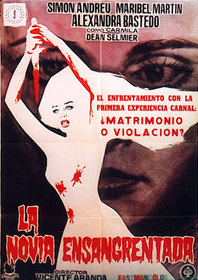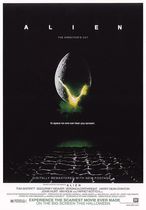Our editor-in-chief Nate Yapp is proud to have contributed to the new book Hidden Horror: A Celebration of 101 Underrated and Overlooked Fright Flicks, edited by Aaron Christensen. Another contributors include Anthony Timpone, B.J. Colangelo, Dave Alexander, Classic-Horror.com's own Robert C. Ring and John W. Bowen. Pick up a copy today from Amazon.com!
The Blood Spattered Bride (1972)
The Blood Spattered Bride (1972) is Spanish director Vicente Aranda's entry into the popular 'Lesbian Vampire' cycle of films popular in Europe at the time. It played to moderate success overseas, and was badly cut and retitled Till Death Do Us Part for the American exploitation circuit. Anchor Bay has recently released a remastered, widescreen, and uncut edition on video and DVD, showcasing a unique and disturbing meditation on sex and marriage.
The film begins as a study of a young brides fear of sexuality. Maribel Martin plays a naive and virginal girl, recently married to an older man (Simone Andreu), whose sexual desires frighten her. She even dreams of being raped, in a chilling early fantasy sequence.
When the husband brings her home, to his family's large estate, she is put little at ease by what she finds. All the pictures of the family matriarch have been consigned to the cellar, and an old curse hangs over the castle. Then, in an extraordinary sequence, Simone Andreau finds a woman buried alive on the beach. The striking, blonde Alexandra Bastedo plays the stranger, and she begins to exert a powerful control over the virginal Maribel Martin.
 Love under a shroud. Alexandra Bastedo and Maribel Martin in Vicente Aranda's The Blood Spattered Bride.
Love under a shroud. Alexandra Bastedo and Maribel Martin in Vicente Aranda's The Blood Spattered Bride.What follows is madness, ancient revenge, and bloody murder, both imagined and real. While it is no secret that the film is a riff on Sheridan la Fanu's classic, Carmilla, it plays ambiguously with idea of vampires. The central figure may be an undead revenant, but director Aranda eschews most of the gothic and mythic trappings of vampires, and leaves the viewer guessing to the very end about the real nature of the villain. He is more interested in the fragile state of the nubile Martin, and her husband's attempts to save her. The ending is as brutal and shocking as it is inevitable.
Like most Spanish directors of the period, Vicente Aranda has an almost old-fashion sensibility to the film. It unfolds slowly, allowing its complex characters to develop. At the same time, its mature sexuality and psychological insight makes more modern that most contemporary horror films. At times, The Blood Spattered Bride borders the realm of soft-core pornography, but its adult approach to the material lends it much more resonance than Hammer Film's 'Lesbian Vampire' films of the same period.









Too bad they torture and kill
Too bad they torture and kill a poor little fox, because it wasn't an half-bad film. But I have no tolerance for animal cruelty, now or then.